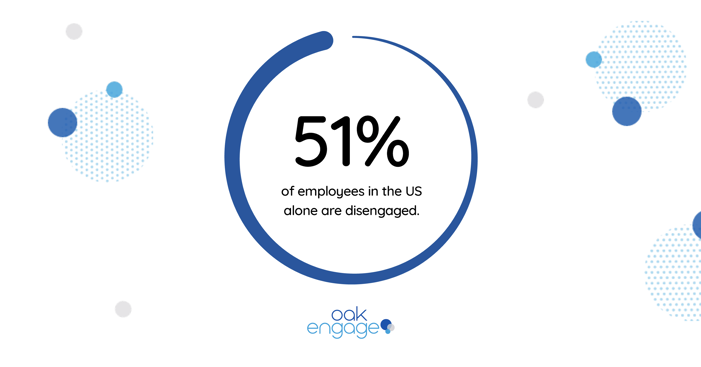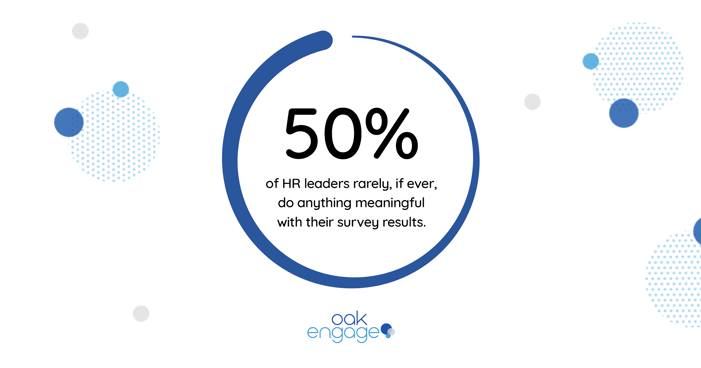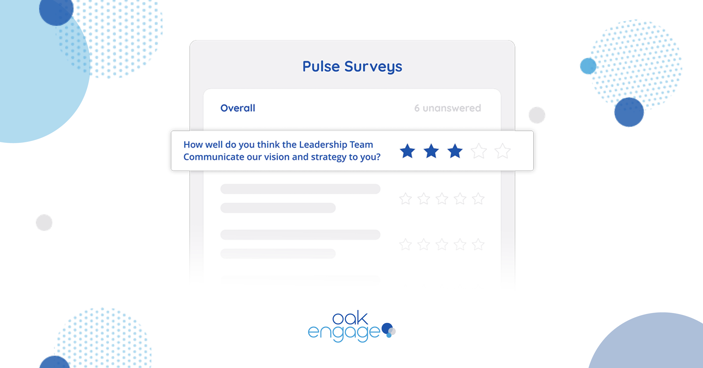Gallup suggests that companies who ranked with the highest levels of employee engagement were 22% more profitable and 21% more productive than those that ranked the lowest. When employees are engaged at work, morale becomes higher, retention increases and your workforce becomes more productive. Ultimately, investing in your employees pays off.
However, for companies who have an ineffective engagement plan, developing and implementing an effective one can be a daunting task. That’s why we’re here to help. In this guide we’ll cover:
- What is an employee engagement action plan?
- Why create an employee engagement plan?
- Benefits of an employee engagement plan
- How to start an employee engagement plan
- Employee Engagement Action Plan [FREE TEMPLATE]
What Is an Employee Engagement Action Plan?
A study conducted by Gallup suggests more than 51% of employees in the U.S alone are disengaged. And 16% of these employees are actively disengaged. These statistics are not only surprising but demonstrate the extreme severity of the situation at hand.
 An employee engagement action plan is a process that an organisation must come up with to identify and prioritise their actions based on their employee engagement rates in the workplace.
An employee engagement action plan is a process that an organisation must come up with to identify and prioritise their actions based on their employee engagement rates in the workplace.
A company should be able to identify quick and simple changes to demonstrate to its employees that the organisation is determined to set in an action plan on receiving any form of feedback about levels of employee engagement.
Why Create an Employee Engagement Plan?
When searching for an employee engagement strategy on google, you will most likely find long lists of random ideas. You'll find solutions like "throw team parties" and "host Friday quizzes"
These are not engagement strategies. They are ideas to keep your workforce engaged.
More often than not, companies spend time and resources on HR initiatives without thinking strategically about them. QuestionPro surveyed and interviewed HR leaders across the globe and a massive 50% of them said, they rarely if ever do anything meaningful with the results of their surveys.
 Here are some examples of what NOT to do:
Here are some examples of what NOT to do:
- Implementing a HR initiative without considering the problem you're trying to solve or if employees will benefit from it.
- Spending money on a program or strategy and not questioning whether your employees want to participate in it.
- Offering benefits that employees don't care for.
However, being strategic about employee engagement means every initiative you invest in addresses a real problem in your company.
This means:
- Understanding the core drivers of employee engagement
- Identifying your employee pain points and creating tailored initiatives accordingly.
- Speaking with or surveying employees to gain insight into what they want from their workplace.
Now, what are the benefits you’ll receive from creating an employee engagement plan?
Benefits of Employee Engagement Action Plans
An employee engagement action plan helps your company to:
- Identify and discuss key engagement drivers
- Commit to the changes that will have the most impact
- Hold everyone accountable for the results of your employee engagement initiatives
Employee engagement is based on trust, integrity, two-way commitment and communication between an organisation and its members. Here are some benefits of implementing an engagement plan:
1. Retaining the Very Best Employees
Workforce retention is an issue for many businesses. Having a suitable employee engagement action plan in place will ensure you retain the employees that are key to your business.
Engaged employees have greater job satisfaction and loyalty, which significantly lowers the risk of them moving to a different company and taking up a position elsewhere.
2. Attract Top Talent
Implementing an engagement plan doesn't just benefit your employees who already work for you. Prospective employees will take note of how appreciated and engaged your existing workforce is.
Businesses that put employee engagement high on their list of priorities tend to find it easier to attract new employees that are qualified, passionate and enthusiastic, making recruitment so much easier.

3. Create a Positive Working Environment
The negative atmosphere created by those who are disengaged can have a detrimental effect on your work environment. But with better engagement, you can keep team morale high.
4. Develop Your Workforce
Employee engagement doesn’t just work wonders for company success. Individual successes will also become apparent. Your employees will have the rewarding opportunity to develop new skills and enhance their existing ones, a prospect that will only add to their self-confidence and enthusiasm.
5. Outperform Your Competitors
The employee engagement experts at Best Companies revealed that firms with highly engaged employees financially perform as much as 3.5 times better than FTSE 100 businesses.
Recommended Reading 📖: Why Is Employee Engagement Important? [Key Benefits]
How to Start an Employee Engagement Plan
Every company faces a different set of challenges when it comes to employee engagement. Regardless of what you’re looking to accomplish with your Employee Engagement Action Plan, you should use the following steps. Our template will also help you to develop an effective plan.
Determine What You Want to Achieve
Before you start gathering data you should:
- Bring together the key leaders of your organisation to discuss what you’ll be working to accomplish with your plan.
- Find out if your company is seeking greater employee retention, boosted morale, employee connectivity or more.
- Have a sense of what you want to achieve before you start collecting feedback from your employees. This will help you gain the most helpful insights from your team.
Collect Feedback From Your Staff
An employee engagement action plan isn’t worth much if it’s not actually improving your employee experience. A crucial part of the employee engagement process is to:
- Get feedback once you’ve implemented your initiatives.
- Ask for feedback and take it into account, but you also know when to stand your ground regarding projects that will have a long-term impact.
- Use the most useful and most effective feedback technique - an employee engagement survey.
- Implement a survey immediately after the launch of your plan, this is the perfect time to start creating an online form where employees can make suggestions.
- Ensure to try out different feedback methods to determine what works best for your company.

OUR TOP TIP:Implement Pulse Surveys Throughout the Year
“Here at Oak, we understand how important it is to keep on top of job satisfaction and employee engagement, which is why our platform enables you to create Pulse Surveys to gather valuable data from your employees with ease. A Pulse Survey can be created in minutes and enables your employees to give their honest feedback, either named or anonymously.”
Review Feedback From Your Staff
Once you’ve collected your feedback, it's important to analyse your survey results to uncover your organisation’s strengths and weaknesses and identify any areas of improvement.
The leadership team should review the results with their workforce. If engagement scores are lower than expected, don’t worry. The aim of a survey isn’t to make your organisation look good, but to make your company better.
You should:
- Focus less on the scores and more on the employee feedback you received.
- Pay attention to any themes or patterns in the results.
- Use comments to put the scores in context and identify reasons you may have scored lower on certain questions.
- Use this feedback as a roadmap for moving forward.
Brainstorm Employee Engagement Ideas
You should start by brainstorming some employee engagement ideas which will eventually turn into long-term wins. This will help you to kick-start the process of improving employee engagement throughout your workforce.
 Some examples are:
Some examples are:
- Recognising achievements often
- Encouraging feedback
- Listen to your employees
- Share ideas
- Emphasise respect
- Increase transparency
A simple way to document your ideas is to outline the following for each focus item:
- How do we struggle in this area?
- Why do you think we struggle in this area?
- What does our team do to help or hurt this outcome?
- In an ideal future, how would this look different?
Recommended Reading 📖: Employee Engagement Strategy For 2021 [Examples Included]
Implement and Monitor
Now that you’ve identified your top solutions, it’s time to commit to your employee engagement action plan. As you define your action plan, be sure to include the following documentation:
- Specific actions you’re committing to
- Who is responsible
- Due dates and timelines
- How success will be measured
- Timeline for progress reports
By clearly outlining the action steps and who is accountable for the results, you can ensure your plan doesn't fall through the cracks.
After implementing your action plan, it’s important to remember to monitor it. Work with your teams to create team goals that are specific to the actions you have committed to and the results you are hoping to achieve. Making these goals public is a simple but effective way to hold teams accountable to the results, measure progress, and share successes along the way.
As weeks and months go by, be sure to follow up with managers and employees who have committed to specific actions. Give progress updates in team meetings or on your intranet platform timeline to help keep engagement on top throughout the year.
Recommended Reading 📖: How to Measure Employee Engagement
Employee Engagement Action Plan [FREE TEMPLATE]
Are you ready to take the next step? Download our employee engagement action plan template. Simple and easy to follow, the template will get your planning off to the best possible start.


![Employee Engagement Action Plan Guide [FREE Template]](/media/y21jatkf/engagement-plan-header.png?width=50)

